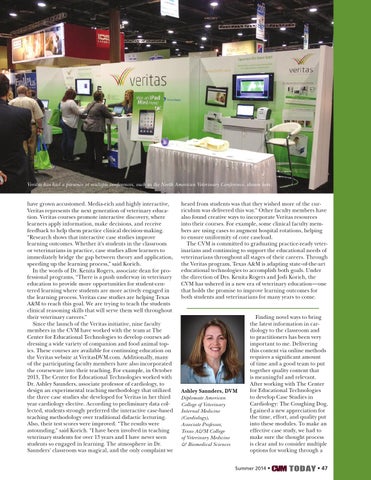Veritas has had a presence at multiple conferences, such as the North American Veterinary Conference, shown here. have grown accustomed. Media-rich and highly interactive, Veritas represents the next generation of veterinary education. Veritas courses promote interactive discovery, where learners apply information, make decisions, and receive feedback to help them practice clinical decision-making. “Research shows that interactive case studies improve learning outcomes. Whether it’s students in the classroom or veterinarians in practice, case studies allow learners to immediately bridge the gap between theory and application, speeding up the learning process,” said Korich. In the words of Dr. Kenita Rogers, associate dean for professional programs, “There is a push underway in veterinary education to provide more opportunities for student-centered learning where students are more actively engaged in the learning process. Veritas case studies are helping Texas A&M to reach this goal. We are trying to teach the students clinical reasoning skills that will serve them well throughout their veterinary careers.” Since the launch of the Veritas initiative, nine faculty members in the CVM have worked with the team at The Center for Educational Technologies to develop courses addressing a wide variety of companion and food animal topics. These courses are available for continuing education on the Veritas website at VeritasDVM.com. Additionally, many of the participating faculty members have also incorporated the courseware into their teaching. For example, in October 2013, The Center for Educational Technologies worked with Dr. Ashley Saunders, associate professor of cardiology, to design an experimental teaching methodology that utilized the three case studies she developed for Veritas in her third year cardiology elective. According to preliminary data collected, students strongly preferred the interactive case-based teaching methodology over traditional didactic lecturing. Also, their test scores were improved. “The results were astounding,” said Korich. “I have been involved in teaching veterinary students for over 13 years and I have never seen students so engaged in learning. The atmosphere in Dr. Saunders’ classroom was magical, and the only complaint we
heard from students was that they wished more of the curriculum was delivered this way.” Other faculty members have also found creative ways to incorporate Veritas resources into their courses. For example, some clinical faculty members are using cases to augment hospital rotations, helping to ensure uniformity of core caseload. The CVM is committed to graduating practice-ready veterinarians and continuing to support the educational needs of veterinarians throughout all stages of their careers. Through the Veritas program, Texas A&M is adapting state-of-the-art educational technologies to accomplish both goals. Under the direction of Drs. Kenita Rogers and Jodi Korich, the CVM has ushered in a new era of veterinary education—one that holds the promise to improve learning outcomes for both students and veterinarians for many years to come.
Ashley Saunders, DVM Diplomate American College of Veterinary Internal Medicine (Cardiology), Associate Professor, Texas A&M College of Veterinary Medicine & Biomedical Sciences
Finding novel ways to bring the latest information in cardiology to the classroom and to practitioners has been very important to me. Delivering this content via online methods requires a significant amount of time and a good team to put together quality content that is meaningful and relevant. After working with The Center for Educational Technologies to develop Case Studies in Cardiology: The Coughing Dog, I gained a new appreciation for the time, effort, and quality put into these modules. To make an effective case study, we had to make sure the thought process is clear and to consider multiple options for working through a
Summer 2014 •
• 47
